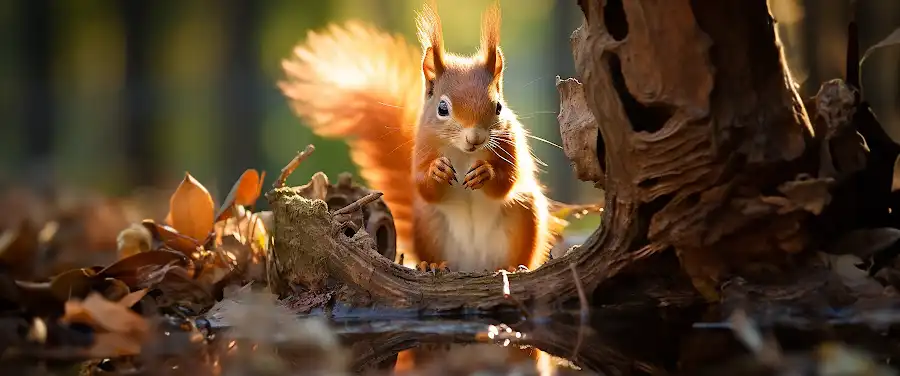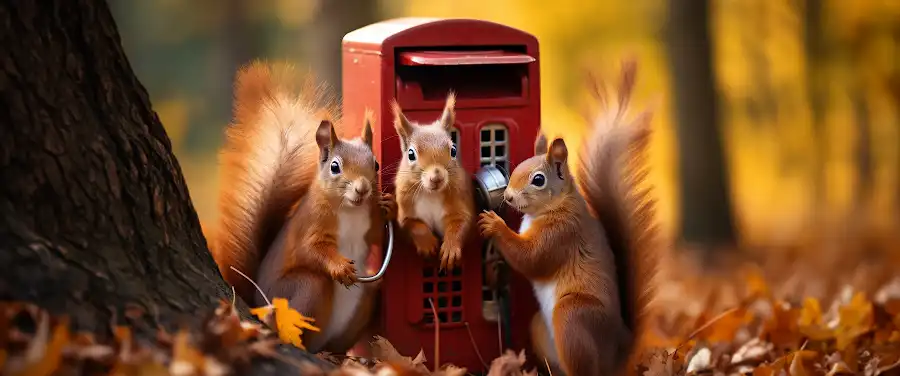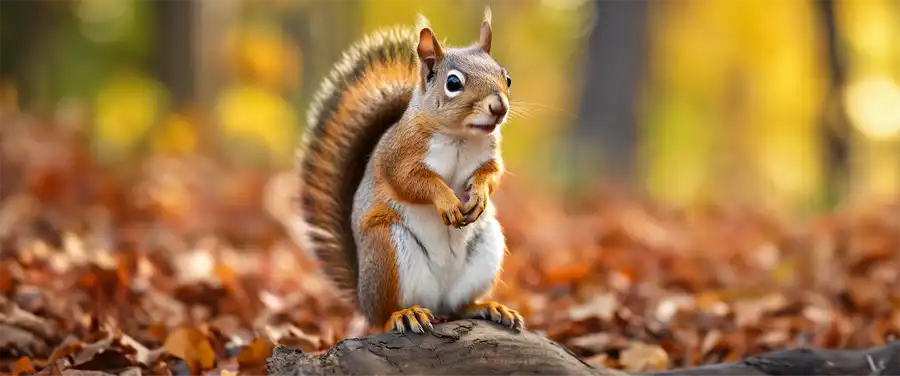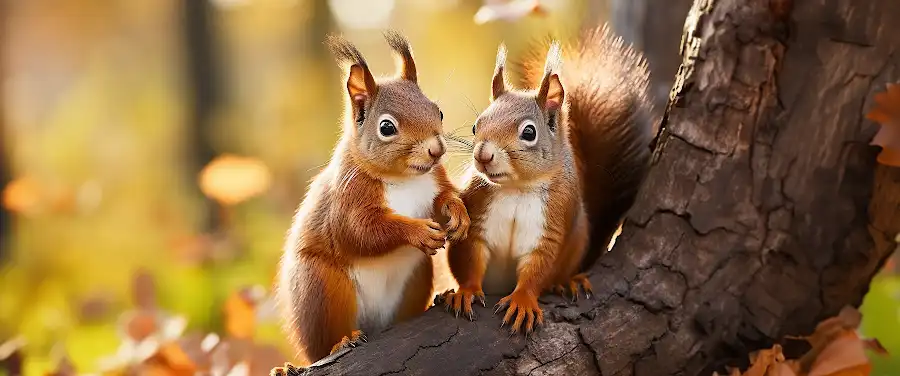
Chances are, you’ve locked eyes with one of these fluffy-tailed creatures, as they masterfully scamper across tree branches or meticulously gather acorns for the upcoming winter. Yes, it’s safe to say that squirrels, the beloved members of the sciuridae family, have carved out a notable presence in our everyday outdoor experiences. But, ever wondered about the complexities hidden under the bushy tails and erratic acrobatic movements? Understanding squirrel behavior and habits extends way beyond their, admittedly, charming demeanor, stretching into an insightful wildlife study that sheds light on the unique quirks of rodent behavior.
Now, why should we care to delve into the behavioral patterns of these industrious critters? Let’s put it this way, getting to know squirrels is not just about satisfying our curiosity, although that is a valid reason. Diving into the world of squirrel antics aids in our broader understanding of ecosystems, animal interactions, altering environments, and even climate change. Moreover, such knowledge can contribute to effective urban planning and the preservation of biodiversity, ultimately fostering harmony between human environments and our squirrel neighbors.
From their food-gathering strategies, intricate nesting techniques, to surprising communication methods, this probe into squirrel behavior and habits promises to be an eye-opening journey. Strap in, folks, as we unravel the secrets kept under the fur and tree canopies! But before we scurry further, it’s worth getting familiar with who we’re dealing with. Next up, let’s meet the different types of this friendly tree inhabitant who’s ruling backyards and city parks across the globe.
How Do Squirrels Communicate?

Analysis of squirrel sounds and vocal communication, body language, and scent marking habits reveal that squirrel communication is more complex than most of us realize. Squirrels play an integral part in the ecosystem, and their ability to communicate significantly affects their social interactions.
Have you ever thought about how squirrels communicate with each other? Yes, squirrels do communicate, and not just through cute chatters or fluffy tail signals. Observing a squirrel may be akin to watching a silent movie, but there’s indeed a lot going on behind the scenes.
Their communication emerges from various tools, including vocalization, body language, and scent marking. Squirrels can use a high-pitched alarm call to alert others to the presence of a predator. Additionally, these furry creatures use their tails as semaphore flags to signal and communicate. Being able to decode these messages will give us a better understanding of squirrel behavior and habits.
What are the Subtle Signs of Squirrel Communication?
Understanding the motions of a squirrel’s tail and their meanings is instrumental in analyzing squirrel communication. Squirrels have several types of tail signals to communicate with. For instance, if a squirrel swiftly flicks its tail, it’s likely alerting another of danger.
Understanding squirrel noises, vocalizations, or sound meanings is another factor key to understanding these intriguing animals. Each squirrel sound, from the high-pitched squeak to the low, throaty chuckle, carries a different message. Alarm calls, for instance, often sound like sharp, piercing shrieks meant to alert others to immediate danger.
Breaking down this language can help us gain a clearer understanding of squirrel behavior and the subtly complex way these creatures interact with their environment. It’s a veritable alphabet that is used to communicate everything from danger to the location of food!
A recent study published in .Nature’s Communications reveals that squirrel communication is so sophisticated that they can even deceived each other by mimicking bird calls. It seems there’s always something new to learn about our furry garden dwellers.
Here’s a quick list of the squirrel’s unique communication habits for you:
- A loud bark or shake of the tail indicates a threat.
- High-pitched squeals and chittering sounds signify excitement or mating calls.
- Squirrels can imitate the sounds of birds to mislead predators.
- Silent tail flicks are a sign of alertness or defensiveness
- Specific scent markings are used to signal territory boundaries.
Knowing that squirrels communicate in such a complex and detailed manner makes it even more interesting to observe these agile little acrobats as they scurry about their day.
In the next section, we will take you through “How Do Squirrels Adapt to Their Environment?” to further deepen your understanding of the squirrel behavior and fascinating survival instincts. It’s an interesting journey you wouldn’t want to miss. Ready? Let’s hop right in!
How Do Squirrels Adapt to Their Environment?

Squirrels showcase an extraordinary aptitude for adaptation. Whether they inhabit bustling urban parks or secluded forest habitats, these agile creatures utilize distinctive survival habits and adaptations to thrive. To grasp their adaptation mechanism, we need to delve into two fundamental aspects of squirrel behavior: their adaptation to different climates and ecosystems, and their nesting and hibernation behaviors.
Squirrels are predominantly found across the world with a few species even surviving in harsh areas such as icy Arctic tundra or scorching desert conditions. Be it the Arctic ground squirrel that regulates its body temperature to survive its hibernation period in the extreme colds or the Antelope ground squirrel in the Mojave Desert that dissipates heat through its tail, squirrels employ various adaptations to they stay resilient in differing climates.
On another note, squirrels present a fascinating study of hibernation behaviors. Not all squirrels hibernate, but for the ones like the eastern chipmunk which do, they prepare by storing food and remaining mostly inactive throughout winter.
What are the Unique Nesting Habits of Squirrels?
Moving on to the intriguing nest-building habits of squirrels, they generally build two types of nests: a dray and a den.
A dray is a lofty, leafy nest built primarily for giving birth and rearing young ones. On the other hand, dens are usually nestled in tree trunks or adapted from old woodpecker holes, and serve as a refuge during cold and inclement weather.
Squirrels showcase artful nest-building behaviors and techniques. They typically start by choosing a secure spot and then collecting materials such as twigs, leaves, and even recycling litter in urban areas. Next, they weave these elements together to provide a safe and warm environment for their young ones, demonstrating truly remarkable squirrel nests making abilities.
| Property | Dray | Den |
|---|---|---|
| Location | Tree branches | Tree trunks |
| Materials used | Twigs, leaves, soft materials | Tree bark, in extreme cases reused woodpecker holes |
| Purpose | Reproduction and rearing young ones | Refuge during cold or inclement weather |
Every aspect of squirrels’ lives, from their survival tactics to their nest building procedures, underscores their well-grounded place in their respective ecosystems. Their ability to adapt and habituate in accordance with their surroundings indeed makes them one of nature’s premier survivalists.
How Do Squirrels Interact with Other Animals?

Squirrels occupy a unique space in the ecosystem where they inhabit. They often interact with a number of different animals, which can either be friendly interactions, neutral relations, or instances of predator-prey dynamics. Their behavior and relationships with other creatures are complex but essential to understand their overall role in ecology and animal behaviors.
Squirrels usually maintain a clear distance from larger carnivores like cats, dogs, or foxes, who often pose as a predatory threat. In contrast, they coexist amicably with species that share similar diet preferences, like birds. These relationships aren’t just about shared habitats or food resources; they play an instrumental part in the overall health and balance of the ecosystem.
In essence, squirrels serve an important role in predator-prey dynamics where they are considered prey for some animals and yet as a predator to others, particularly insects, small snakes, and eggs. The population dynamics of squirrels, therefore, have a significant influence on the populations of other species in the ecosystem, both directly and indirectly. For instance, squirrels help plant diversity thrive by forgetting where they buried their food, leading new plants to grow in different spaces.
How Do Squirrels Handle Threats in Their Environment?
One aspect of squirrel behavior that’s been widely observed is their reaction to threats. Just like several other animals, squirrels also showcase a special type of defensive behavior when they perceive danger. The most typical responses are either a flight response or a faked battle preparation – a classic instance of ‘flight vs. fight response.’
Squirrels are agile and fleet-footed, entailing their first reaction to danger would be to flee up a nearby tree or dart into a burrow. Such quick and immediate flight responses are essential for their survival amidst the ecological threats in their environment.
However, when retreat isn’t feasible, squirrels put on a show of bravado and even aggression as a defense mechanism. They puff up their fur, chatter loudly, and move erratically to confuse their predator—an attempt to appear larger and more intimidating than they actually are, buying themselves a bit of time to flee. A study by Department of Ecology and Evolutionary Biology at the University of Guelph found squirrels engaging in tail-flagging, a behavior meant as a warning signal to other group members in presence of a potential danger from predators.
The world of squirrels is filled with unique behavior and habits which reflect their adaptability and intelligence in a competitive natural world. Their responses to threats and interaction with other animals is but one facet of their fascinating existence.
Join us as we delve into the next subject of discussion, namely, ” What is the Social Structure and Behavior of Squirrels?” to learn more about these agile little creatures and their intriguing, complex social organization and life.
Conclusion
As we draw this fascinating exploration of squirrel behavior to a close, we realize just how intriguing these little creatures are. Their habits are remarkably complex, loaded with intricate nuances that have profound ecological implications. Being foragers and hoarders, squirrels play an invaluable role in seed dispersal, inadvertently shaping the flora of their environments.
Understanding squirrel behavior is not an academic exercise for wildlife enthusiasts alone, it is an appreciation of the delicate balance between species within our ecosystems. Their activities, notably their seasons of planning and hoarding, offer insights into the cycles of nature, making them remarkable environmental indicators. Hence, the significance of continual research into squirrel behavior and habits cannot be overstated.
You may not be a biologist, but you can still take part in squirrel observation. In fact, you might be astonished at how much watching squirrels can evoke a sense of wildlife appreciation. If you have squirrels in your neighborhood, take a moment to observe their fascinating behavior patterns, their extraordinary gaming strategies or even their dexterity in tree navigation.
Who knows, you might just stumble upon an intriguing pattern or an extraordinary squirrel attribute that could captivate the scientific world! In other words, never underestimate the power of the curious squirrel, nor your ability to contribute to the understanding of these critters.
In conclusion, our little bushy-tailed friends are more than just eye candy for nature lovers. They embody a host of remarkable behaviors and functions that are crucial for environmental balance. Next time you stumble upon a squirrel, remember they’re not just charming critters hopping about. They play a significant role in the grand tapestry of life, their actions resonating within, and even beyond, their habitats.
| Squirrel Habit | Importance |
|---|---|
| Foraging | Helps in food dispersion and supports various ecosystems |
| Hoarding | Indicates seasonal shifts and climate patterns |
| Predatory evasion skills | Reflects their adaptive and survival abilities |




